If you want to enjoy stunning hanging basket displays this spring, summer and fall, all without having to break the bank – then you need to consider growing your own hanging baskets from seed this year!
Not only can you save a lot of money in the process, you can also control the type of plants and flowers you include in your baskets. The possibilities are almost endless when you plant and grow your own baskets from seed, giving you the chance to grow unique and gorgeous baskets you just can’t find anywhere else.
It’s no secret that purchasing hanging baskets each and every year can get extremely expensive. When you are on a tight budget (and who’s not anymore!), that can really limit the size and amount of displays you can purchase.
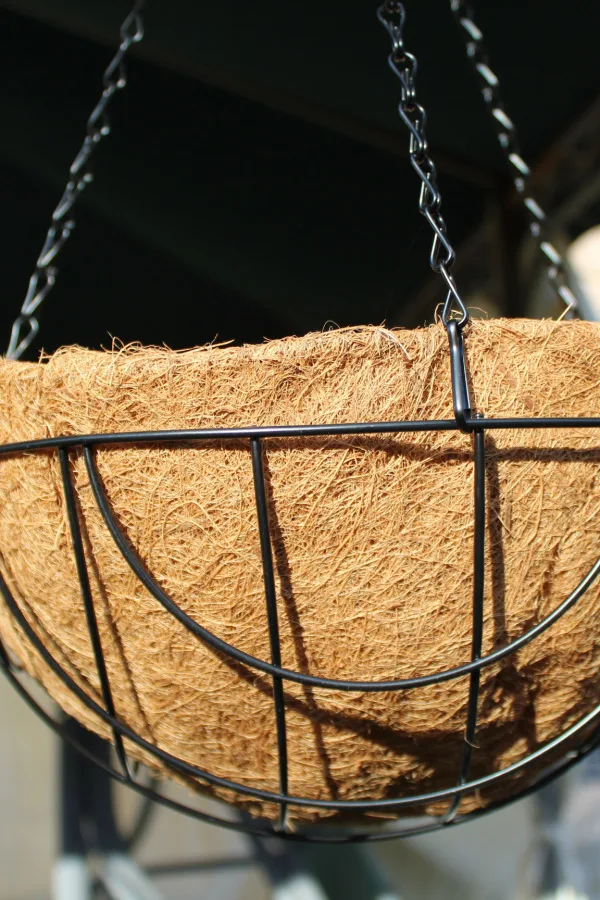
Sure, those nursery-created displays are eye-catching, full of bright colorful blooms, and packed to the brim. But, you can easily create your own amazing display just by using seeds!
Flower seeds are easily accessible, way cheaper than transplants, and the extras can be kept for future use. However, there are a few tips to keep in mind if you want to create your own impressive hanging basket displays using only seeds.
Choosing The Right Seeds
When you start to look at seed catalogs, browse online stores, or even just walk down the seed packet aisle at your local big box store, you might get a little overwhelmed with all the different types of plant seeds available.
So before purchasing, take just a little bit of time to do some research about what seed varieties grow well for your specific location. This is especially true if purchasing seeds from catalogs or online stores. They typically show you all the varieties available – not just those for your location. Thankfully, if you are purchasing your seeds in person, most stores will only carry seeds that work with your specific location.
You also want to take a little time to see what plants grow best in hanging baskets. You might be surprised and what type of annuals and even perennials you can add to hanging baskets or containers.
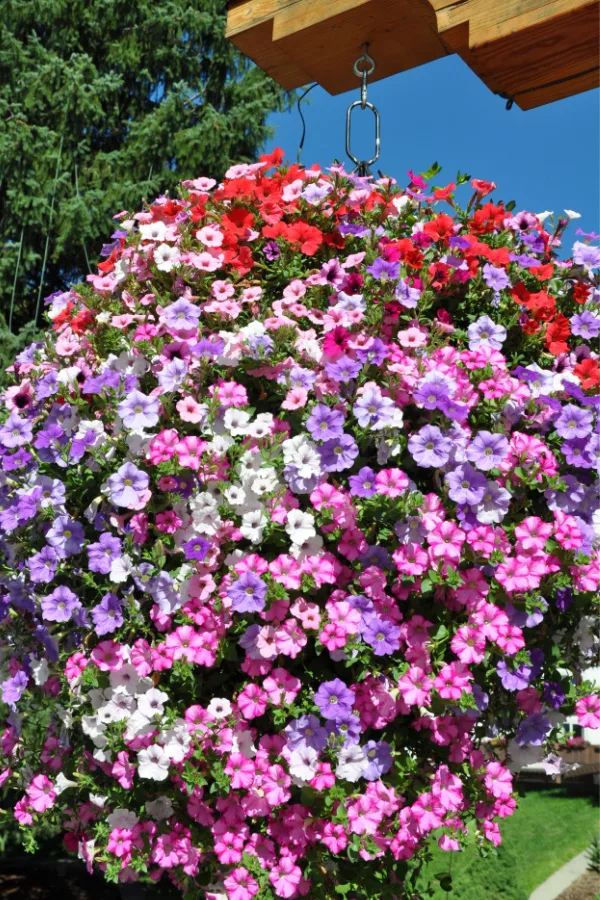
There are of course traditional favorites like petunias, million bells, impatiens, and begonias. But don’t discount other eye-catching flowers like lantana and fuchsia. Even non-flowering plants like ornamental peppers and coleus can make great hanging basket displays. Just be sure to find out varieties that work for your climate.
Consider the mature size of the plants when growing and creating your hanging basket displays. Play around with different textures, colors, and sizes to create a unique and fun look. The possibilities are endless when you are using your own seeds!
Growing Your Own Hanging Baskets From Seeds
Since you want your hanging basket displays to be full and lush when the weather warms up, you will need to get a head start on growing your seeds by starting them indoors. In order for the plants to be ready in the spring, the seeds of most flower varieties will need to be started around 10 to 12 weeks before your last frost date.
Just like you would with vegetables and other plants, you will need a small number of items to start your seeds indoors. Don’t worry, this doesn’t mean the items are super expensive or hard to get by any means!
Inexpensive Containers
First, you will need some sort of seed-starting container for your seeds to grow. This can be anything from a store-bought seed tray to empty toilet paper rolls.
The container just needs to be able to hold the soil as well as allow excess water to drain out. This allows you to start multiple seeds and then choose which ones are growing the best to use in your hanging baskets.
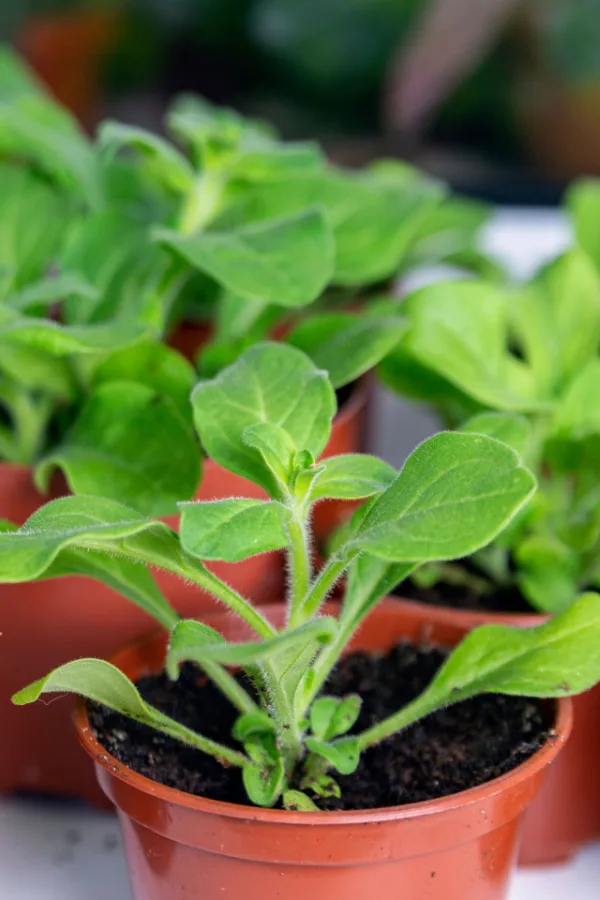
However, if you have the space, you can just start your seeds in the growing basket itself. Plant a few more seeds than needed and then thin the seedlings to proper spacing once they have grown a few inches tall.
If starting the seeds in small containers, you will need to transfer the seedlings once they are about 4 to 6 weeks along. You can either transfer them to the growing basket or to larger containers if needed.
Proper Lighting
The second thing you need to grow your own hanging baskets from seed is proper lighting. Plants need light in order to grow, and this is no different when you are starting seeds indoors. Thankfully, you don’t need to purchase expensive “grow lights.”
In fact, regular fluorescent or LED shop lights work perfectly for this task. Just make sure to keep the lights a couple of inches above the plants in order to keep seedlings from reaching toward the light and growing leggy. Simply move the lights up as the plants grow taller.
Using an inexpensive and easy-to-make tabletop light stand can help make the process a bit easier. However, you can just prop the lights up on bricks or another safe object as well.
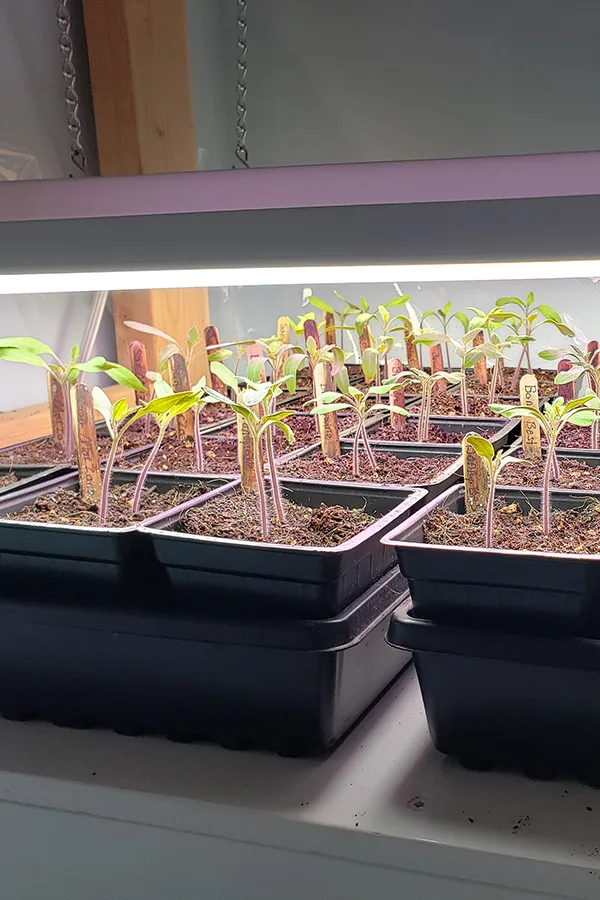
Avoid Windowsills
While it might sound appealing, it isn’t the best practice to start your seeds on a windowsill. Not only will the plants struggle to get enough sunlight to grow properly, but the seedlings will often become extremely leggy and tall as they try to reach toward the sunlight.
Soil & Watering
Besides the containers and lighting, you also need soil and proper watering for your hanging basket seeds. For the soil, you want to choose a high-quality potting soil mix. The mixture should be loose and lightweight and packed full of organic matter.
You can make your own potting soil mix or you can purchase it from online retailers or storefronts. (If you’d like to learn about making your own mix, be sure to check out “The Perfect Homemade Potting Soil Recipe.”)
When it comes to watering your indoor starts, keep the soil evenly moist but not saturated. Once the top inch starts to dry out, add more water and allow any excess to drain out. You can also bottom water seedlings as well, but avoid keeping them in standing water for more than 30 minutes.
Moving Outdoors
Once the temperature allows, it’s time to get your plants outside. If you had kept your plants in smaller containers, you will want to transplant them into your hanging baskets now.
Again, keep in mind the plants’ mature size when transplanting, but have fun creating unique displays. You are free to combine whatever plants you like together, just maybe make sure the plants all have about the same requirements for watering and sunlight.
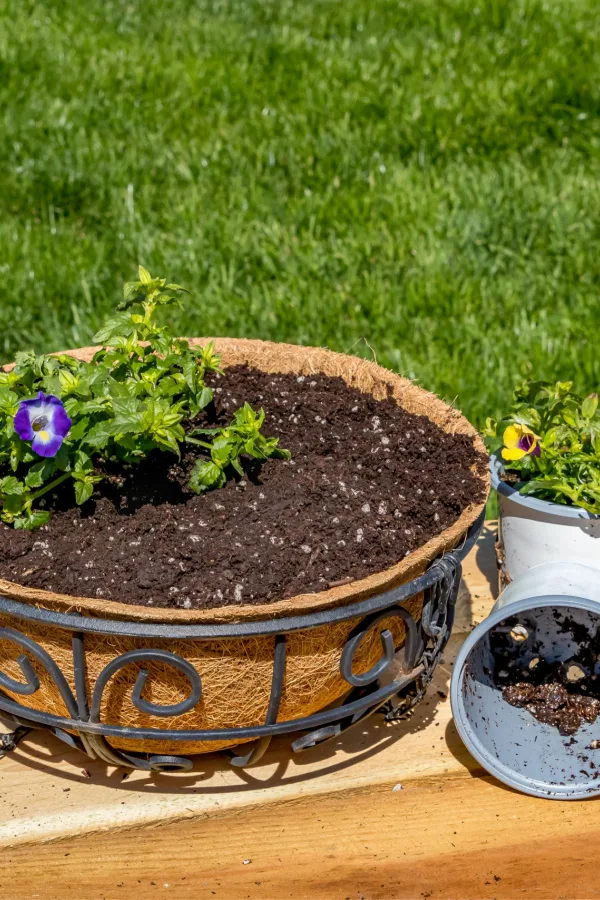
Move your hanging baskets out gradually. Keep the baskets out of harsh winds to keep them safe. In addition, be sure to bring them back inside if the temperatures drop or during poor weather. After a week or two, the plants will likely be ready to be kept in their final location.
The nice thing about using hanging basket plants is that they are very easy to change locations and bring inside if you experience a late-season frost or freeze!
Spring & Summer Care
Be sure to keep the hanging baskets that you started from seeds properly watered through their growing season. The plants will likely need to be watered daily, but check the soil to be sure. Always water plants early in the morning and at the soil line whenever possible.
Since hanging basket soil only has so many nutrients available, you will need to add fertilizer. The best tip is to apply a weaker dose of fertilizer over a longer period of time. Low and slow is the key here. You can also use compost tea or worm casting tea as a great alternative. Applying the fertilizer every two to three weeks should be enough to keep your hanging baskets looking full and lush all growing season long.
Also, be sure to deadhead most flower varieties to allow the flowers to continually produce blooms all growing season long. In no time at all, your seed-started hanging basket displays will look just as good if not better than those expensive store-bought arrangements!
Follow Our Facebook Page For Even More Great Tips! Simple Garden Life Facebook Page
Simple Garden Life is a website dedicated to keeping gardening fun, simple and enjoyable! We publish two new articles each week along with a new garden podcast episode every two weeks. This article may contain affiliate links.
